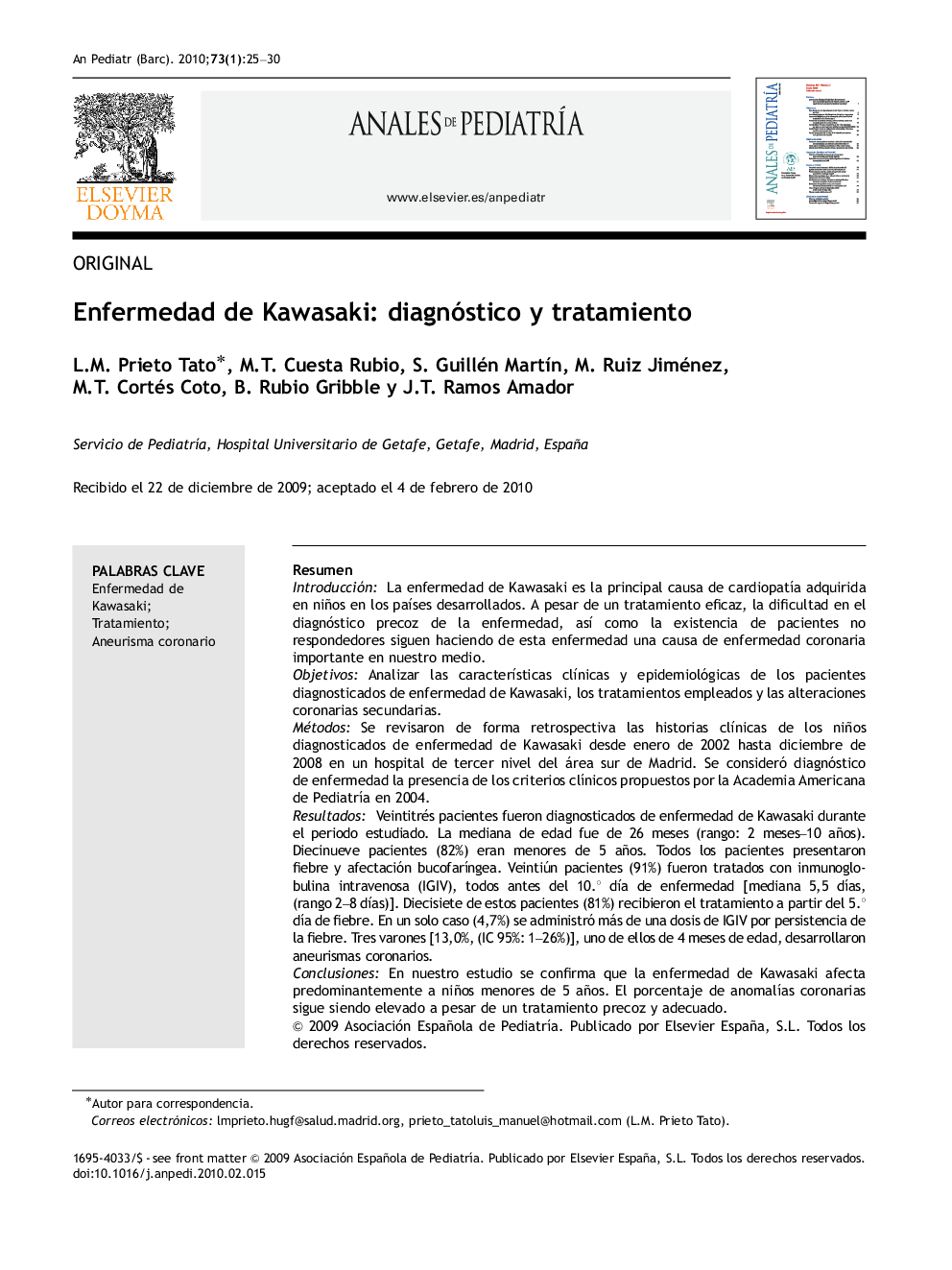| کد مقاله | کد نشریه | سال انتشار | مقاله انگلیسی | نسخه تمام متن |
|---|---|---|---|---|
| 4142307 | 1272367 | 2010 | 6 صفحه PDF | دانلود رایگان |

ResumenIntroducciónLa enfermedad de Kawasaki es la principal causa de cardiopatía adquirida en niños en los países desarrollados. A pesar de un tratamiento eficaz, la dificultad en el diagnóstico precoz de la enfermedad, así como la existencia de pacientes no respondedores siguen haciendo de esta enfermedad una causa de enfermedad coronaria importante en nuestro medio.ObjetivosAnalizar las características clínicas y epidemiológicas de los pacientes diagnosticados de enfermedad de Kawasaki, los tratamientos empleados y las alteraciones coronarias secundarias.MétodosSe revisaron de forma retrospectiva las historias clínicas de los niños diagnosticados de enfermedad de Kawasaki desde enero de 2002 hasta diciembre de 2008 en un hospital de tercer nivel del área sur de Madrid. Se consideró diagnóstico de enfermedad la presencia de los criterios clínicos propuestos por la Academia Americana de Pediatría en 2004.ResultadosVeintitrés pacientes fueron diagnosticados de enfermedad de Kawasaki durante el periodo estudiado. La mediana de edad fue de 26 meses (rango: 2 meses–10 años). Diecinueve pacientes (82%) eran menores de 5 años. Todos los pacientes presentaron fiebre y afectación bucofaríngea. Veintiún pacientes (91%) fueron tratados con inmunoglobulina intravenosa (IGIV), todos antes del 10.° día de enfermedad [mediana 5,5 días, (rango 2–8 días)]. Diecisiete de estos pacientes (81%) recibieron el tratamiento a partir del 5.° día de fiebre. En un solo caso (4,7%) se administró más de una dosis de IGIV por persistencia de la fiebre. Tres varones [13,0%, (IC 95%: 1–26%)], uno de ellos de 4 meses de edad, desarrollaron aneurismas coronarios.ConclusionesEn nuestro estudio se confirma que la enfermedad de Kawasaki afecta predominantemente a niños menores de 5 años. El porcentaje de anomalías coronarias sigue siendo elevado a pesar de un tratamiento precoz y adecuado.
IntroductionKawasaki disease is the leading cause of acquired heart disease in children. In spite of the efficacy of intravenous immunoglobulin (IGIV), the absence of a specific diagnostic test and due to there being IGIV-refractory patients, Kawasaki disease is a major cause of coronary artery abnormalities (CAA).ObjectivesTo analyze the clinical and epidemiological characteristics of cases of Kawasaki disease, to evaluate the efficacy of treatments used and the CAA observed.MethodsWe retrospectively reviewed the medical records of children diagnosed with Kawasaki disease between January 2002 and December 2008 in a tertiary public Hospital in the South of Madrid. The diagnosis of Kawasaki disease was based on the clinical criteria proposed by the American Academy of Pediatrics in 2004.ResultsTwenty three children were identified. Median age was 26 months (range: 2 months–10 years). Nineteen children (82%) were younger than 5 years old. Fever and changes in the lips and oral cavity were present in all cases. Twenty-one patients (91%) received IGIV, all of them before the 10th day of disease. One child (4.7%) required the administration of more than one dose of IGIV, because persistence of fever. CAA was recorded in three patients [13.0%, (95% CI: 1–26%)], including a four month-old boy. All patients with CAA were treated with the recommended dose of IGIV, 2 g/kg, between the 5th and 8th day of disease.ConclusionsKawasaki disease was more common in children less than five years old. We observed a high rate of CAA in children with Kawasaki disease in spite of appropriate and timely treatment.
Journal: Anales de Pediatría - Volume 73, Issue 1, July 2010, Pages 25–30